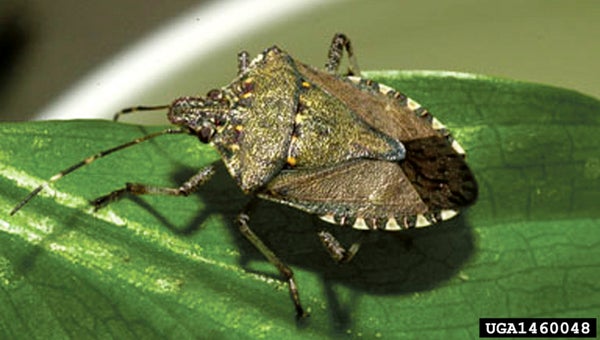
By Rudy Yates | Regional Extension Agent in Agronomic Crops
A native of Asia, the brown marmorated stink bug (BMSB), Halyomorpha halys, is an exotic pest that invades homes and feeds on a large number of plants, including ornamentals, fruit, vegetables and farm crops.
This insect was first identified in Pennsylvania in 1998.
Now, the BMSB has been detected in at least 30 states, including Alabama.
The first detection of BMSBs in Alabama was in 2011. These pests were found in Jefferson, St. Clair and Lee counties.
In 2013, BMSBs were identified in Autauga, Limestone and Shelby counties. This pest will hitchhike in cars, trucks, campers, planes, etc. The stink bugs found in St. Clair County were in a camper.
The BMSB was first reported as a nuisance pest in homes, schools and businesses in the northeastern United States. However, this pest caused significant losses in apple and peach orchards in 2010.
The BMSB has a wide range of hosts, including apples, citrus, figs, lima beans, peaches, persimmons, green peppers, soybeans, sweet and field corn, tomatoes and various trees, shrubs and weeds. Cotton and pecans may be hosts as well.
The adult BMSBs can range from 1/2 inch to slightly less than an inch long. They have the same shield shape common to most stink bugs. Their coloring is marmorated (marble like) shades of brown, yellow and grey.
The BMSB can be distinguished from other stink bugs by the alternating dark and light bands on the last two segments of the antennae and also on the exposed side edges of the abdomen. This is their most distinguishing characteristic, but the BMSB can be confused with our native brown stink bug. Typical of other stink bugs, the BMSB emits a pungent odor when disturbed.
The eggs of BMSBs are barrel shaped and light green in color. They are laid from May through August (possibly into September) on the underside of a leaf in a cluster of 25. The egg mass becomes apparent once the nymphs emerge because the nymphs will stay at the egg mass for several days.
The five nymphal stages range in size from 0.1 inch to 0.5 inches. Nymphs have red eyes and their abdomen is yellowish-red. The yellowish-red color eventually turns to off-white in the last nymph stage.
Researchers think there will be multiple generations as the BMSBs spread south.
It is only a matter of time before we see this new invasive pest throughout Alabama. When you’re out checking your landscape, garden, orchard or field crops and you come across a stink bug as previously described, collect it and please contact your county Extension office. We want to track the movement of this pest.
In regard to tracking the movement of the BMSB, Extension agents and specialists had placed traps around crops last year to check for their presence. I monitored two traps in Dallas County and one trap in Lowndes County for the stink bug. No BMSB were found in any of my traps.
There are a number of Extension and university websites that have much more information and pictures of the BMSB. Penn State has a BMSB fact sheet that can be found at http://ento.psu.edu/extension/factsheets/brown-marmorated-stink-bug.
The University of Florida has information and pictures of the BMSB that can be accessed at http://entnemdept.ufl.edu/creatures/veg/bean/brown_marmorated_stink_bug.htm.
The Northeast IPM (Integrated Pest Management) has a series of YouTube videos listed at http://www.youtube.com/user/NortheastIPM/.
No natural enemies have been found in the United States for the BMSB. Researchers are conducting studies to determine the most safe, economical management strategies to control this pest.
Homeowners are encouraged to seal cracks around windows, doors, chimneys and other openings with a good quality silicone or silicone-latex caulk. This will reduce entry points for this future pest as well as other pests we currently have such as cockroaches and the multicolored Asian lady beetle. Repair or replace damaged screens on doors and windows.
Other control strategies can be obtained by contacting your county Extension office.
